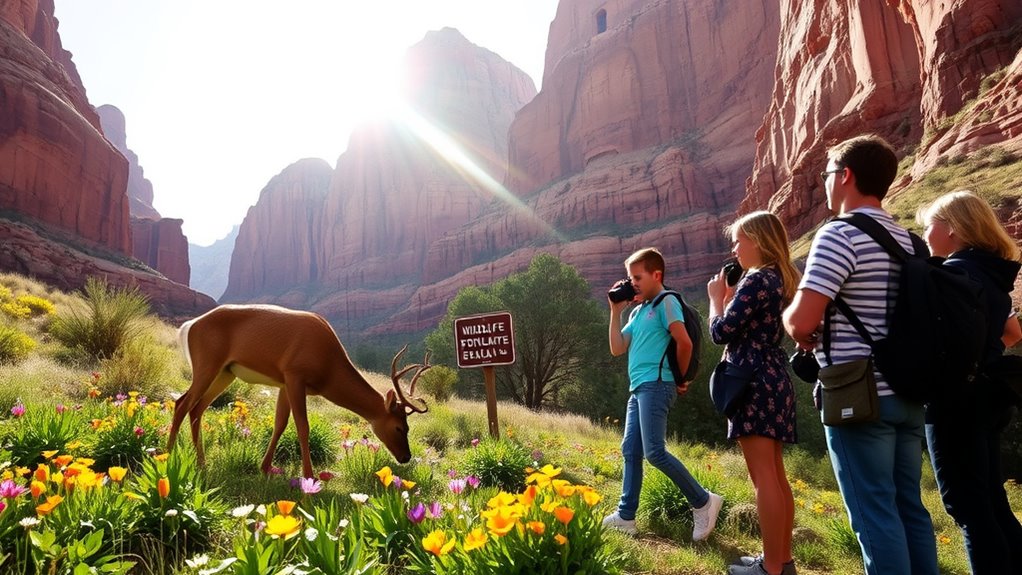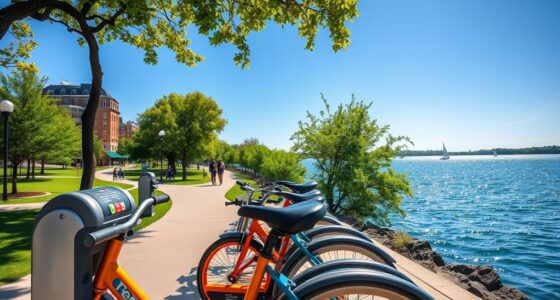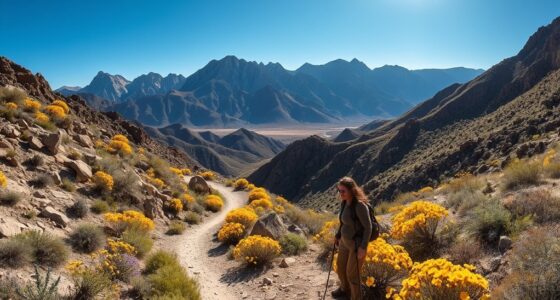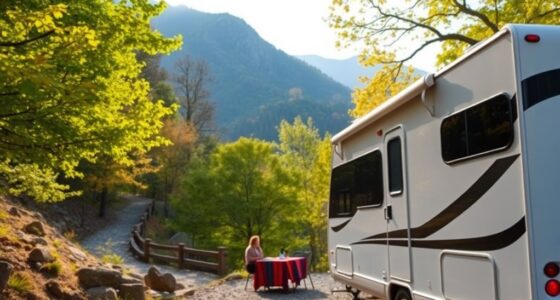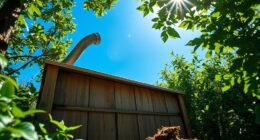When enjoying wildlife at Zion National Park, keep a safe distance and avoid feeding animals. Use zoom lenses for great photos without intruding, and stick to marked trails to protect habitats. Keep noise levels low and only use natural lighting for captures. Lead by example to promote respectful behavior among fellow visitors. Your actions matter for preserving the park’s beauty. There’s more to discover about protecting wildlife and enhancing your experience.
Key Takeaways
- Maintain a safe distance from wildlife to avoid disturbing their natural behavior and ensure your safety.
- Use zoom lenses for photography to capture images without intruding on animals’ habitats.
- Stick to marked trails to protect ecosystems and prevent habitat damage.
- Keep noise levels low and avoid sudden movements to minimize stress on wildlife.
- Lead by example in promoting respectful visitor behavior, fostering a culture of responsibility among park visitors.
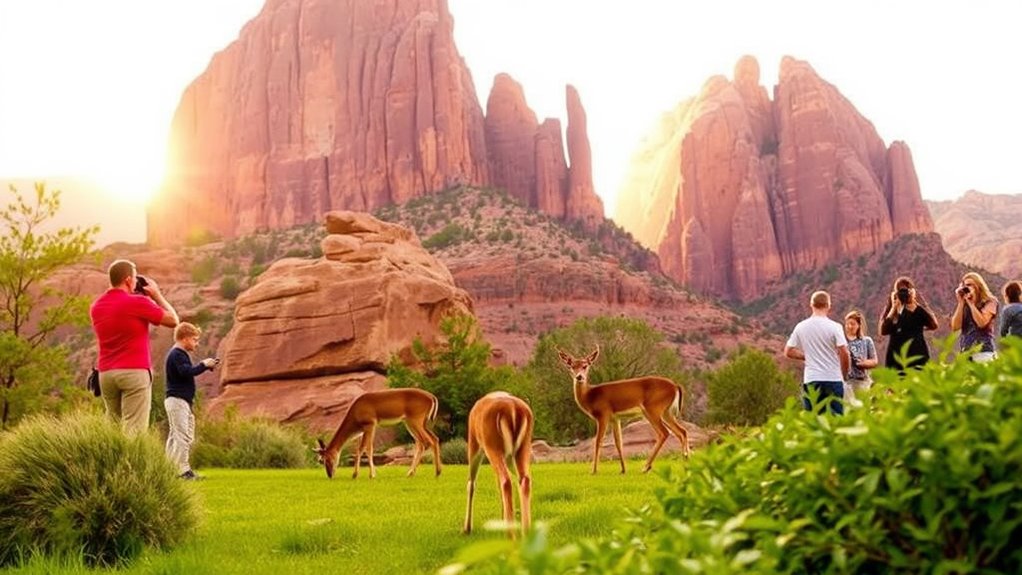
When you venture into nature to observe wildlife, it is vital to remember that you’re a guest in their habitat. Being respectful and responsible is key to guaranteeing that both you and the animals can coexist peacefully. In Zion National Park, where diverse species thrive, following proper wildlife viewing etiquette is indispensable. You’ll want to appreciate the beauty around you while minimizing your impact on these creatures and their environment.
As a guest in wildlife habitats, respect and responsibility ensure peaceful coexistence in nature’s beauty.
One of the most important rules is to avoid feeding wildlife. It might seem harmless to toss a few crumbs to a curious squirrel or bird, but this practice can have serious consequences. Feeding wildlife can lead them to rely on human food sources, which disrupts their natural foraging behaviors. Additionally, animals that become accustomed to human interaction can become aggressive or dangerous. You wouldn’t want to inadvertently harm an animal by encouraging dependency or putting yourself in a risky situation. Instead, admire them from a distance, allowing them to act naturally without interference.
When it comes to capturing those breathtaking moments through photography, you’ll need to adhere to some basic photography guidelines. Always remember to keep a safe distance from the animals while taking pictures. This not only guarantees your safety but also respects the animals’ space. Use a zoom lens to get close-up shots without physically intruding into their territory. This way, you can capture stunning images while still allowing wildlife to behave as they would without human presence.
Moreover, avoid using flash photography. Bright lights can startle animals and disrupt their natural behaviors, potentially scaring them away or causing stress. Instead, opt for natural lighting and consider visiting during the golden hours of sunrise or sunset for the best shots. While you’re at it, keep noise to a minimum. Loud voices or sudden movements can frighten wildlife, making it less likely for you to see them.
In addition, always stick to marked trails and paths. Venturing off the beaten path can damage delicate ecosystems and disturb animal habitats. Finally, if you see other visitors behaving disrespectfully, don’t hesitate to speak up. By promoting proper wildlife viewing etiquette, you contribute to a culture of respect and care for the natural world. Your actions set an example, and together, we can guarantee that future generations enjoy the wonders of Zion National Park just as you do today.
Remember, practicing smart shopping for gear and equipment can enhance your wildlife viewing experience while respecting the environment.
Frequently Asked Questions
What Types of Wildlife Can I Expect to See in Zion National Park?
In Zion National Park, you can expect to see a variety of native species, including mule deer, bighorn sheep, and numerous bird species like peregrine falcons. As you explore, pay attention to their behaviors—deer often graze in the early morning or late evening, while bighorn sheep might be seen scaling rocky cliffs. Remember, observing these animals from a distance allows you to appreciate their natural habits without disturbing them.
Are There Specific Seasons Best for Wildlife Viewing in Zion?
Yes, certain seasons are better for wildlife viewing in Zion. Spring and fall are ideal, as you’ll witness seasonal migration and animals preparing for breeding seasons. In spring, look for newborn animals and increased activity, while fall brings vibrant colors and animals gathering before winter. Summer can be hot, making wildlife less active during the day, but early mornings and evenings can still offer great opportunities to spot various species.
Can I Bring My Pet While Wildlife Viewing in Zion?
You can’t bring your pet while wildlife viewing in Zion. In fact, nearly 80% of park visitors choose to leave their pets behind to protect animal safety and preserve the natural habitat. Pet restrictions are strictly enforced, so it’s best to plan ahead. Consider finding a pet-friendly area outside the park or arranging for a sitter. This way, you’ll guarantee both your pet’s well-being and a more enjoyable experience for yourself and the wildlife.
Is There a Guided Tour Option for Wildlife Viewing in the Park?
Yes, there are guided tour options for wildlife viewing in the park. You can join organized wildlife viewing programs that enhance your experience and increase your chances of spotting animals. These tours are led by knowledgeable guides who share insights about the park’s ecosystem and wildlife. By participating, you get a more immersive experience and learn about the importance of conservation. So, consider booking a tour for an unforgettable adventure!
What Should I Do if I Encounter a Wild Animal?
If you encounter a wild animal, think of yourself as a spectator in nature’s grand theater. Maintain a safe distance, keeping animal safety at the forefront of your mind. Avoid sudden movements or loud noises that could startle the creature. Instead, observe quietly, allowing the moment to unfold. Use binoculars for a closer look, and remember not to feed or approach the animal. This way, you’re a respectful guest in their world.
Conclusion
In Zion National Park, over 200 species of birds and numerous mammals call this stunning landscape home, showcasing its rich biodiversity. As you explore, remember that respectful wildlife viewing is essential. Keep your distance, don’t feed the animals, and stay on marked trails to protect their habitats. By following these simple guidelines, you’ll help preserve the park’s natural beauty for future generations while enjoying the incredible sights and sounds of nature around you.

